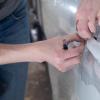5 Ways To Make Your Car As Safe As Possible
When it comes to car safety, there is always more than can be done. For parents already familiar with extended rear facing car (ERF) seats, what else can do you to ensure the best possible safety? Aside from buying a new car, here are a few things you can do to increase the protection offered by your own vehicle.
Check Your Crumple Zones
When it comes to head-on or rear collisions, the crumple zones are where a lot of the kinetic energy or impact is meant to be absorbed. Specifically, a car actually has two crumple zones, one each at the front and rear of the vehicle, protecting the main cab body where people sit. As the name implies, these zones crumple on impact, reducing the pressure passed on to the passengers.
Modern cars are designed to have strong crumple zones and these are often taken into account when testing (such as for EU road safety standards). However, this is for a new car in its prime condition. If your car is old, or has a few bumps and knocks already, this might inherently weaken the crumple zone itself. If this is the case, it is highly worth getting your car inspected, to see if anything can be done to restore the strength and durability.
Improve Your Brakes
When it comes to emergency stops and other surprise maneuvers, a fast braking speed is essential. The shorter your car can come to a stop, the higher your chance of avoiding collisions. For this, you can look at two key areas - the brake discs themselves and the car tyre.
Brake mechanisms in the front wheels - where most of the breaking occurs - include brake discs, pads and rotors. Often, you might find only one item needs replacing, but it’s a wise idea to replace all of the parts at once to ensure high quality brake pads are always in place. This is also true if you don’t use the car frequently, as this could actually allow corrosion to build up.
Brake discs will wear out over time, as they are always in use. The rate at which they deteriorate depends on your how often you drive and your personal driving habits. Nonetheless, if the car starts to make extra noise or feel less responsive when driving, it’s time to change something.
Fit The Right Tyres
Since the tyres are the only part of the car that makes contact with the road, it shouldn’t be a surprise to learn the your choice of tyres can make a big difference. They can provide better grip, for instance, which only helps to offer a better braking distance.
Similarly, the right tyres can also help with difficult weather conditions, such as rain and wet roads. Aquaplaning, for example, lifts the car above the road when there is too much water, although the right choice of summer tyres will help push the water out. Winter tyres are also worthwhile in the winter, as the name implies, since these focus on better grip and performance on slippery surfaces.
It’s also worth checking that the tread is of a roadworthy standard. If it’s too worn out, even high quality brake pads will be drastically less effective. A simple test requires the use of a 20p coin. Push this into the tread and see if the outer band disappears into the rubber. If it doesn’t, your tyres are too thin and need replacing.
Check Your Seatbelts
Of course, a sharp braking speed also has it’s own problems. A strong, secure seat-belt is always recommended for children too old for ERF seats, as this will protect them when braking quickly. When fitting children in, always check to see they are fitted securely. As for yourself, you should always wear a seatbelt. Remember that airbags are considered supplemental restraint systems - they only work alongside seatbelts, not as replacements.
Similarly, while it might be tempting to save money, safety equipment is one area where it’s often better to buy first-hand goods. Pre-owned items might have some wear and tear that isn’t immediately obvious, or the internal mechanisms might not be working correctly. This is especially true when you consider the item’s unknown history, as it might have already been involved in a crash or incident, or even given away because it’s very quality and performance was lacking.
Collision Avoidance Systems
Many new cars come with advanced collision avoidance systems already installed but, thankfully, this modern technology can be retrofitted onto older models. These enhancements use sensors or radar to determine if cars in front, behind or to the sides of you are too close. More than just shaping your own driving to be as safe as possible, this will warn you about potential collisions while you have opportunity to react to it.
However, there are some limitations to retro-fitted models. This is because they require various sensors to be installed. More advanced systems can detect when you’re veering off the road, using cameras to detect road markings, but these are much harder to install on vehicles that were not designed with this in mind. What can’t be installed, however, is automatic braking, as this would require connecting these systems directly to the brakes.
As you can see, there are many ways you can improve your car safety in addition to ERF seats. All of these methods are useful in their own ways but, combined together, they ensure any vehicle can be as safe as possible.
More to Read:
Previous Posts:



